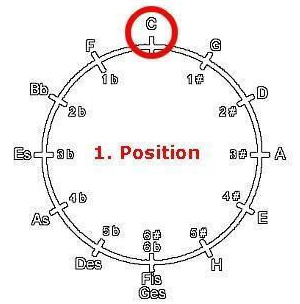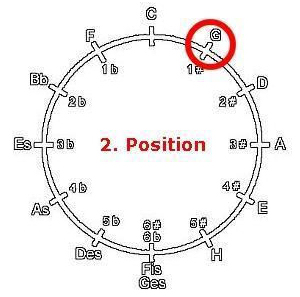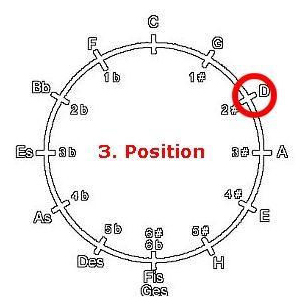Positions
The First Position
If you take a diatonic harmonica in C, the key in the first position is also C-Major. In the Circle Of Ffths, the C is found "right up in the middle".

All blown notes that are played in this position on the harmonica without bending fit this key without restriction and immediately form a C Major chord, also known as the tonic . Therefore, the harmonica always sounds harmonious - even if played by an absolute beginner.
Table 1: Tone Table Standard Richter C
| Blow | C1 | E1 | G1 | C2 | E2 | G2 | C3 | E3 | G3 | C4 |
| Hole | 1 | 2 | 3 | 4 | 5 | 6 | 7 | 8 | 9 | 10 |
| Draw | D1 | G1 | B1 | D2 | F2 | A2 | B2 | D3 | F3 | A3 |
The tones marked in red in Table 1 form the normal C major scale, which can be played very easily in the first position.
If you now play the pull chord, you get the dominant chord G major belonging to the C tonic.
In simple folk music, the first chord of the chord progression is always the tonic and the dominant chord is the second important one. As this strives for the tonic again, the chord sequence "rolls" on, as if driven by an inner urge. This effect is very strong and such songs are usually felt to be particularly rousing and are also suitable for marching music.
The first position is therefore predestined for folk songs and easy melodies, although one can also play blues.
However, this only is hearable if you can play the so-called 'Blue Notes', which are particularly difficult to achieve in this position.
Blue notes are as much a part of the blues as salt is in a soup. These are the tones of the 3rd, 5th and 7th degrees of the major scale. They are intoned emotionally and, depending on the performer, played a little lower than normal (up to a semitone). They can only be reached in the first position through the particularly difficult overblows.
Especially beginners instinctively play the harp in first position, but nothing sounds like blues - so here we have a first hurdle to overcome - the blues works much better in 2nd position.
Second position or cross harp
designates the key that follows the first key in the circle of fifths, raised by a fifth. If you take a diatonic harmonica in C, the key of the second position is G major.

All drawn notes that are played in this position on the harmonica without bending fit into this key without restriction and immediately form a G major chord, which this time does not sound as a dominant, but as a new tonic . In 1-6 draw a seventh chord sounds , in our example on the Richter Blues Harmonica in C this is a G 7/9 chord.
The tone marked in purple in Table 2 shows the new root chord G, B, D, together with 5 and 6 draw it is the G 7/9 chord (in red).
Table 2 : Standard Richter C in 2nd position G
| Blow | C | E | G | C | E | G | C | E | G | C |
| Hole | 1 | 2 | 3 | 4 | 5 | 6 | 7 | 8 | 9 | 10 |
| Draw | D | 1 | B | D | F | A | B | D | F | A |
A blues scale in G looks like this:
Tabel 3:
| Bluesscale in G |
G | Bb | C | C#/Db | D | F | G |
tabs: -2 -3b 4 -4b -4 -5 6
It is striking that in G almost all the tones of the blues scale can be found on the harmonica, sometimes twice and three times, the root even four times. This is very convenient for the player. Blues on the harmonica is therefore mostly played in 2nd position.
Table 4 : Standard Richter C in 2nd position, blues scale notes
| Blow | C | E | G | C | E | G | C | E | G | C |
| Hole | 1 | 2 | 3 | 4 | 5 | 6 | 7 | 8 | 9 | 10 |
| Draw | D | G | B | D | F | A | B | D | F | A |
Only two of the blues scale notes are missing: the Bb and Db. These tones can only be reached via bending , ie lowering a natural tone by one or more semitones (these important tones are marked green in Table 5 )
Table 5 : Standard Richter C, bending tones in 2nd position
| Blow bening | 1 | 2 | 3 | 4 | 5 | 6 | 7 | Eb | Gb | Bb |
| Blow | C | E | G | C | E | G | C | E | G | C |
| Hole | 1 | 2 | 3 | 4 | 5 | 6 | 7 | 8 | 9 | 10 |
| Draw | D | G | B | D | F | A | B | D | F | A |
| Draw bending | Db | F | Bb | Db | 5 | Ab | 7 | 8 | 9 | 10 |
All tones of the blues scale can be reached using the bending technique - this forms the basis for the success of the Richter harmonica in blues and rock music, where it can still often be heard and, in the case of blues, even plays a major role.
Chords in the 2nd position
The chord concept is such that the blow chord C of the C harmonica has become the subdominant , i.e. it plays a completely different musical role compared to the harmonic concept of the first position.
The subdominant chord fits with thte first chord change in blues perfectly, which is always formed by the subdominant chord (IV) (IIII - IV IV - I...) . At the same time, the root of the tonic (I), i.e. the G, occurs three times in this chord. So as a player you can hardly do anything wrong.
With a little blues feeling, it is therefore quite easy to achieve remarkable results on the blues harmonica within a short time.
Third Position or 'Double Cross'
designates the key that follows the second key (here G) in the circle of fifths, again a perfect fifth away. If you take a diatonic harmonica in C, the root key of the third position is D.

The tone marked in purple in Table 6 shows the new fundamental D root note for third position.
Table 6 : Standard Richter C
| Blow | C | E | G | C | E | G | C | E | G | C |
| Hole | 1 | 2 | 3 | 4 | 5 | 6 | 7 | 8 | 9 | 10 |
| Draw | D | G | B | D | F | A | B | D | F | A |
A Blues Scale in D looks like this:
Table 7: Blues scale in D
| Bluesscale in D |
D | F | G | Ab | A | C | D |
tabs: -1 -2 3 3b -3 4 -5
The root note is found here only three times compared to the second position and only when drawn.
Other notes of the Blues Scale are relatively unavailable directly.
Table 8: Standard Richter C in 3rd postion, notes of the Blues Scale in D minor
| Blow | C | E | G | C | E | G | C | E | G | C |
| Hole | 1 | 2 | 3 | 4 | 5 | 6 | 7 | 8 | 9 | 10 |
| Draw | D | G | B | D | F | A | B | D | F | A |
The root note is found here only three times compared to the second position and only when drawn. Other notes of the blues scale are relatively unavailable directly.
The missing tone down can be reached by bending in channel 6 (Ab - marked in bold green in Table 9 ). The adjacent tones F and A together with the root D form a D minor chord. Therefore, the third position is usually used for blues pieces in minor keys - in this case D minor. Most of the scale tones are in the middle register, but the important tones F and A are "missing" in the lower register. These must be produced on the Richter harmonica by whole-tone bending (dragging from G to F in 2 and pulling from B to A in 3 ), which often causes great difficulties, especially for beginners.
Table 9 : Standard Richter C, bending tones in 3rd position
| Bllow bending | 1 | 2 | 3 | 4 | 5 | 6 | 7 | 8 | 9 | 10 |
| Blow | C | E | G | C | E | G | C | E | G | C |
| Hole | 1 | 2 | 3 | 4 | 5 | 6 | 7 | 8 | 9 | 10 |
| Draw | D | G | B | D | F | A | B | D | F | A |
| Draw Bending | 1 | F | A | 4 | 5 | Ab | 7 | 8 | 9 | 10 |
The chord concept:
Since the root, in this example D, is a drawn D pieces are mainly played in D minor. This chord is formed in channel 4 to 6 as well as channel 8 to 9 .
When changing the key to the fourth degree, i.e. the subdominant chord (IV) in minor, in this example a triad with the tones G-Bb-D = G minor, you can play tones similar to those in the 2nd position G (while strictly avoiding the note B in 3 and 7!).
If you find it difficult to play the necessary notes F and A in 2nd and 3rd draw, you can use a tuning variant of the Richter harmonica. This is called Do it or Easy 3rd tuning and can be ordered in the harp configurator - in this tuning, compared to the Richter tuning, the F and the A in 2nd and 3rd draws are available as natural tones and therefore do not have to be played down and intoned. As a result, the third position is extremely smooth "by hand". Also lovers of Irish folk, in which pieces are often played in the Dorian mode.
![]()







